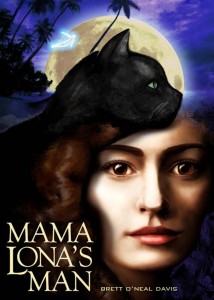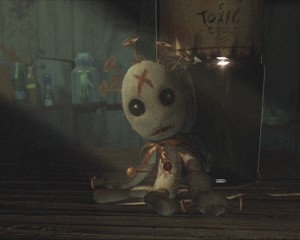Bewitching Book Tours: Mama Lona’s Man by Brett O’Neal Davis
 We had the pleasure of catching up with Brett Davis on his web-wide tour of Mama Lona’s Man a zombie/voodoo thriller, and he was kind enough to answer a few questions we felt our Zombie Survival Crew brigadiers would be interested in.
We had the pleasure of catching up with Brett Davis on his web-wide tour of Mama Lona’s Man a zombie/voodoo thriller, and he was kind enough to answer a few questions we felt our Zombie Survival Crew brigadiers would be interested in.
Mama Lona’s Man
The Straw Man Series, Book One
by Brett O’Neal Davis
Genre: Paranormal Romance
Number of pages: 219
Word Count: 74,000
Cover Artist: Cate Meyers
Book Description:
Mama Lona’s Man combines a Caribbean love story with a zombie thriller. It’s a bit James Bond, a bit “How Stella Got Her Groove Back” and a dash of “Night of the Living Dead.
The leading man is an ex-Navy SEAL controlled by a witch doctor. When he meets an American girl caught up in island intrigue, they fall in love even though he’s been dead longer than she’s been alive.
-
When did you first begin writing, and what inspired you to write your first book?
-
I have been writing my whole life, although I didn’t start trying seriously to write a novel until I was 21 years old. I have always enjoyed reading, mainly novels, so at some point it seemed natural to try to create one of my own. I have nothing against short stories—they are very hard to do well—I just have always tended to think in terms of longer stories, so novel writing was more natural to me. And, this is going to sound bad, but when I was younger I read “Less than Zero” and thought, I could do that. So I tried.
-
What books and authors have most influenced your life?
-
I have always been most impressed, I think, by authors whose work I find very difficult at first. I am a huge fan of the poet Dylan Thomas, whose imagery can be very dense and hard to tease apart. I am amazed at the career of William T. Vollmann, whose “You Bright and Risen Angels” blew me away, although I still don’t think I quite understand it. I also admire J.R.R. Tolkein. I got through “The Hobbit” easily enough as a kid, but it took me a lot longer to be able to tackle “Lord of the Rings.” I am envious of the ability to create a world that people can inhabit as if it’s real, and someday maybe I’ll achieve something like that. And, although he’s largely forgotten as a writer per se, I’ll add Ian Fleming to this list. My zombie character was greatly inspired by the James Bond series. Not the movies, but the books.
-
Tell us a little about your main characters. How easy/difficult was it for you to write a 20-year-old college girl and at the same time climb into the head of a dead ex-Navy Seal?
-
Abigail Callisto is a troubled but brilliant young college student whose father works for the government in a very hush-hush intelligence role. Her mother died when she was young and she doesn’t remember much about her. She’s very self-reliant and couples an artistic temperament with a real genius for electronics. Randy Straw, short for Ravinell, is a young SEAL who was killed in the invasion of Grenada in 1983. For reasons that are detailed in the book, he’s brought back to life as the slave of a witch doctor. He’s a young man removed from the effects of time, kind of like a more muscular Peter Pan.
Each character presented a unique challenge. I have been privileged to know a lot of smart, strong women in my life and I drew upon all of them in creating the character of Abigail. The toughest part was writing about her computer hacking ability. She’s much, much smarter than I am. As for Randy, I did a fair amount of research on Navy SEALS but the hardest part was trying to cast my mind back to the world of 1983, which is the last time he was really connected to the world of the living. He has no idea what a cell phone is and the hottest computer of his day was probably a Commodore 64.
-
Faced with a world infested with flesh-eating biters, what would be your go-to method of defense and why?
-
I admire Daryl Dixon’s work with the crossbow, so I’m going to have to go with that. It’s quick and quiet and doesn’t attract more biters. Maybe if I really wanted a good workout I would switch to a regular bow, and if I were being truly he-man I would make my own bow from a tree that I chopped down, with maybe zombie gut for string.
-
In this ever-changing world, it behooves us to be prepared for disaster to happen at any moment. The Zombie Survival Crew members have a “go-bag” filled with items essential for their survival should disaster strike and they must flee to survive. What are the most essential items for your go-bag and why?
-
A bunch of contact lenses and fluid so I could see (I really need to get Lasik done before the apocalypse arrives). A digital camera and a laptop. Once the plague passes, people are going to want a record of what happened and I intend to corner that market. A solar charger, so the laptop and camera won’t die. Some clean underwear. Coffee beans, and some kind of coffee-making device, maybe one of those little French-press things. Because without caffeine, I just wouldn’t care.
-
How did you come up with the premise for Mama Lona’s Man? And what do you feel makes your book stand out in the zombie and voodoo lit world?
-
I got the general idea for “Mama Lona’s Man” quite a long time ago, when my uncle gave me a cool set of original edition James Bond books that were published in the late 1950s and early 1960s. The books have a different vibe from the movies … they’re almost as much travelogue as adventure, because Bond goes to fun places and Fleming liked to describe them at some length. And, of course, Bond never gets killed. So I started thinking about having a secret agent type who cannot be killed, which led me to make him a zombie, and I wanted the setting to be a Bond-like romp in the Caribbean, and the rest started to fall into place. It took a long time, though. It wasn’t until I focused the book around my lead female character, Abigail Callisto, instead of my zombie hero, Randy Straw, that it fell into place and really became something that could sustain a short series.
As for what makes it stand out, I think it’s the sort-of return to the classic Haitian zombie model of old. I say “sort of” because I play pretty fast and loose with actual historical Voodoo practice, and I just flat out made up some things to suit my story, which calls for the zombie man to be truly dead but not in an icky way. There are some other sexy zombies out there, but they are in the minority, and I think the way I created mine is unique.
-
Is there anything you find particularly challenging in writing for a horror audience?
-
Being scary is the hardest thing for me. Even though there are some pretty horrific scenes in the book, in the main it’s not particularly scary. In general I find movies to be more effective in actually scaring people than books, because if you’re reading a book and get creeped out you can always look at your cat or something to reassure yourself, but you can’t really do that if you’re in a dark theater.
-
Tell us a little bit about your work with robotics. Are there things we could use come the dawn of the zombie apocalypse?
-
I edit a magazine, published by a trade association, that covers unmanned systems and robotics. I couldn’t put a robot together if you gave me a Lego kit and built half of it in advance, but I like to talk to people who can. And, yes, there are many systems that would come in handy when the end times begin. Any kind of far-seeing sensor that would tell you where the shambling hordes are at any given time would be handy, and there are a lot of those out there. The forward-looking infrared sensors that can detect body heat would probably not be of much use against zombies, but a ground robot with a machine gun on top would be just the thing.
-
What are you working on now? Can you tell us your latest news?
-
I am plotting out more adventures for Abigail Callisto and Randy Straw, the heroes of “Mama Lona’s Man.” I’m picturing a five-story arc. I already know how it’s going to end, just am not positive yet how I’m going to get there. Also, I spent a big chunk of last summer shooting a (very) low-budget vampire movie with some great actors from the DC area. I’m just beginning the editing on that, which will take a while, but should be a lot of fun. I hope it will show up on a screen near you at some point in 2013. It may be an iPad screen, but that’s still a screen.
-
Is there anything you would like to say to your readers?
-
Yes … please give me feedback on my zombie man and his brainy gal as their adventures progress. I want their adventures to span the globe, so please contact me via my blog and let me know where you’d like them to go. Don’t just read the adventures, help direct them. And, pay attention to the advice you get from the Zombie Survival Crew. You just might need it!
Brett O’Neal Davis is a native of Florence, Ala., and attended the same high school as Sam Phillips, who discovered Elvis Presley. He studied journalism at the University of North Alabama and the University of Missouri, writing about music whenever possible. He also briefly “fronted” the one-man punk band Screwhead. Despite clearing $1.50 in profit on consignment sales of the band’s lone album at Salt of the Earth Records in Columbia, Mo., he turned to the slightly more stable world of aerospace and defense journalism, working today in the field of unmanned systems and robotics in Washington, D.C.
He is the author of four science fiction and fantasy novels, all published by Baen Books. The first, The Faery Convention, was listed among the best fantasy novels for 1995 by Science Fiction Chronicle, and Two Tiny Claws was named to the 2000 Books for the Teen Age List by the New York Public Library. An occasional panelist at area science fiction conventions, he also has discussed fiction writing at National Press Club events and at literary festivals, including the annual T.S. Stribling celebration at the University of North Alabama. Mama Lona’s Man is his first foray into paranormal romance, but it won’t be the last.
Smashwords | Amazon | Website | Twitter | Goodreads


